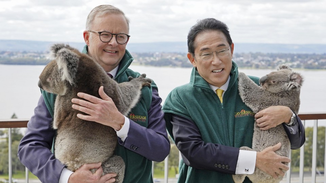 Source: Kyodo Press
Source: Kyodo Press The principle takeaway from the updated Declaration was language outlined under Article 6, stating that “we will consult each other on contingencies that may affect our sovereignty and regional security interests, and consider measures in response.” As was commented upon at length by Australian journalists and assorted analysts, this sentence has a strong resemblance to that found in the ANZUS treaty with its commitment to consultation when faced with a potential threat.
It marked a turning point in Japan’s security relations with its near(er) neighbours, given that Japan had not made similar commitments with any other country other than the United States in the postwar era. This development, coupled with the signing of the Reciprocal Access Agreement in January last year, signaled that Japan and Australia now share a similar security outlook predicated on closer defence ties between like-minded partners.
The process by which this shared view came about was certainly not spontaneous, but has been steadily building over the past decade ever since the first Joint Declaration on Security Cooperation was signed in 2007. It was also not an entirely linear process – many pre-existing assumptions and, it must be said, doubts had to be overcome before the administrations of both countries could be convinced to work more closely in defence of regional security.
Many years ago I wrote that one of the principal drawbacks to Japan seeking an alliance with Australia was the seeming lack of ‘balance’ in any bilateral defence treaty – namely, that Australia’s military presence was not significant enough nor urgent enough to convince Tokyo to push for the creation of an alliance (not to mention the numerous constitutional and legislative arguments that would need to be resolved before such negotiations could commence in earnest).
This observation predated the arrival of Xi Jinping and a much more militant, nationalistic stance adopted by the Chinese Communist Party and the Peoples’ Liberation Army. While there is little immediate prospect for either country to want to push for an alliance, what is more likely to occur is for both countries to work in tandem to secure regional stability, particularly over the question of Taiwan. While both countries have not changed their respective Taiwan policies, what they have done is signal in unequivocal terms that they expect any question about Taiwan’s future to be decided peacefully.
This shared concern over the fate of Taiwan has spurred a great deal more dialogue between both governments on how any attempt by China to seize Taiwan by force can be resisted, with both governments agreeing that deterrence is the most effective means of ensuring a democratic Taiwan’s survival. Deterrence by either country by itself would be less likely to intimidate China, but a combined plan for deterrence, incorporating not only bilateral assets but those of regional partners (the US, India, possibly South Korea, and maybe even Vietnam) would be a much more effective by merely complicating Chinese military planning and introducing an element of uncertainty surrounding each nations’ commitment to Taiwan – the “will they or won’t they?” argument.
In the meantime what will make the new defence dynamic between Australia and Japan more credible will be increased levels of exercises and personnel exchanges between both countries. Japan and Australia have decades of experience in undertaking joint training with their mutual ally the United States, but more limited experience in working together exclusively. This particularly applies to the ADF, whose interaction with the SDF has predominantly involved short-term training exercises with limited numbers of personnel. To really make significant progress in joint deterrence, much larger and more ambitious exercises will need to be undertaken encompassing all areas of defence – from the three services, to cyber security, space security, hypersonics, quantum computing, unmanned systems etc.
The legislative framework and associated regulations for such exercises to occur are all in place. All that’s needed now is for both sides to put the time and effort in to building their nascent service ties and grasp the opportunities that the present state of the relationship has provided.
 RSS Feed
RSS Feed